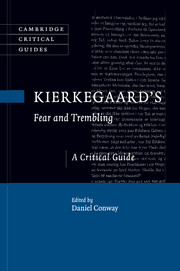Book contents
- Frontmatter
- Contents
- List of Contributors
- Acknowledgments
- List of Abbreviations
- Introduction
- Chapter 1 Homing in on Fear and Trembling
- Chapter 2 Fear and Trembling’s “Attunement” as midrash
- Chapter 3 Johannes de silentio’s dilemma
- Chapter 4 Can an admirer of silentio’s Abraham consistently believe that child sacrifice is forbidden?
- Chapter 5 Eschatological faith and repetition: Kierkegaard’s Abraham and Job
- Chapter 6 The existential dimension of faith
- Chapter 7 Learning to hope: the role of hope in Fear and Trembling
- Chapter 8 On being moved and hearing voices: passion and religious experience in Fear and Trembling
- Chapter 9 Birth, love, and hybridity: Fear and Trembling and the Symposium
- Chapter 10 Narrative unity and the moment of crisis in Fear and Trembling
- Chapter 11 Particularity and ethical attunement: situating Problema III
- Chapter 12 ‘He speaks in tongues’: hearing the truth of Abraham’s words of faith
- Chapter 13 Why Moriah?: weaning and the trauma of transcendence in Kierkegaard’s Fear and Trembling
- Bibliography
- Index
Chapter 13 - Why Moriah?: weaning and the trauma of transcendence in Kierkegaard’s Fear and Trembling
Published online by Cambridge University Press: 05 February 2015
- Frontmatter
- Contents
- List of Contributors
- Acknowledgments
- List of Abbreviations
- Introduction
- Chapter 1 Homing in on Fear and Trembling
- Chapter 2 Fear and Trembling’s “Attunement” as midrash
- Chapter 3 Johannes de silentio’s dilemma
- Chapter 4 Can an admirer of silentio’s Abraham consistently believe that child sacrifice is forbidden?
- Chapter 5 Eschatological faith and repetition: Kierkegaard’s Abraham and Job
- Chapter 6 The existential dimension of faith
- Chapter 7 Learning to hope: the role of hope in Fear and Trembling
- Chapter 8 On being moved and hearing voices: passion and religious experience in Fear and Trembling
- Chapter 9 Birth, love, and hybridity: Fear and Trembling and the Symposium
- Chapter 10 Narrative unity and the moment of crisis in Fear and Trembling
- Chapter 11 Particularity and ethical attunement: situating Problema III
- Chapter 12 ‘He speaks in tongues’: hearing the truth of Abraham’s words of faith
- Chapter 13 Why Moriah?: weaning and the trauma of transcendence in Kierkegaard’s Fear and Trembling
- Bibliography
- Index
Summary
The image precedes him. For those who have read the writings of the Danish thinker, and for many who have not, the name “Kierkegaard” summons with it the image of a bearded patriarch, knife flashing, hovering above the bound body of his son. However much one would avert one’s eyes from the tableau which Kierkegaard unreservedly sets at the gateway to the authorship, however much one might wish to dwell on other aspects of his work – his thinking on temporality and anxiety, or his vivid evocation of the abundance of a life lived in trusting immersion in finitude – the image returns. Caravaggio’s The Sacrifice of Isaac comes closest: there we see an aging but by no means feeble Abraham, gripping Isaac’s head with one frank, muscular hand, pressing the knife close to the neck with the other. There is no mistaking the sense that, in the opening passages of Fear and Trembling, more precisely in Johannes de Silentio’s versions of the Akedah, something unbearable, or well nigh so, approaches. If this is a book about faith and trust, it is also a book about their failure, about the possibility of their (unspeakable) collapse. Perhaps it is not too much to say that the entirety of Kierkegaard’s writings remains suspended, like the raised knife, at this juncture. True to his own established practice, we will approach this intersection in terms philosophical, biographical, psychological, and literary. I wish to clear a path so my reader may approach the specter of a suffering which far exceeds the loss of any Regine, a suffering, may we call it trauma, which left Kierkegaard, like his Antigone, virtually without friends, without children, with only the breath-taking beauty of a language which could never adequately name his secret.
- Type
- Chapter
- Information
- Kierkegaard's Fear and TremblingA Critical Guide, pp. 247 - 262Publisher: Cambridge University PressPrint publication year: 2015



